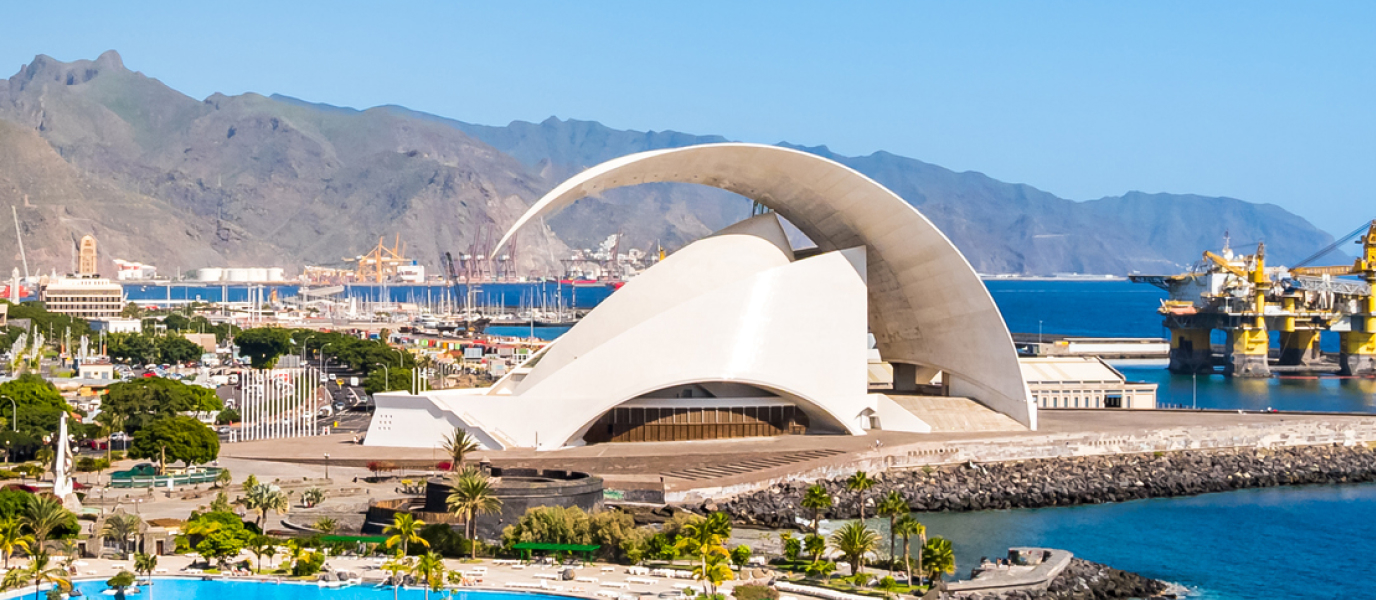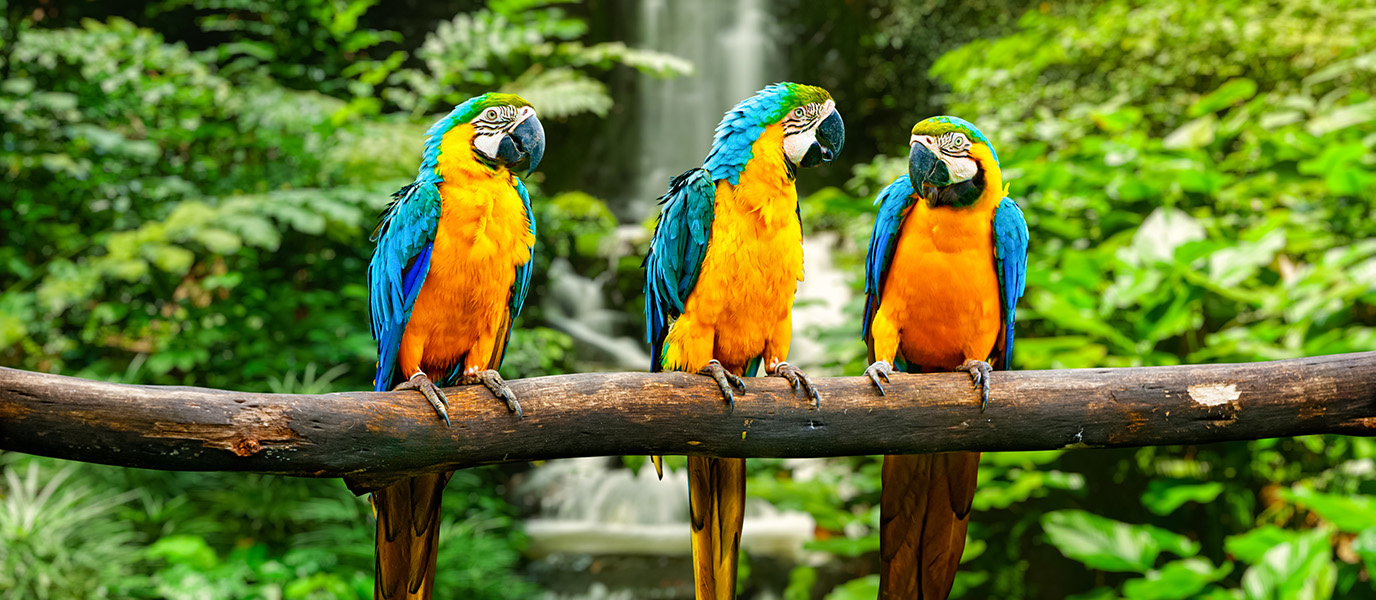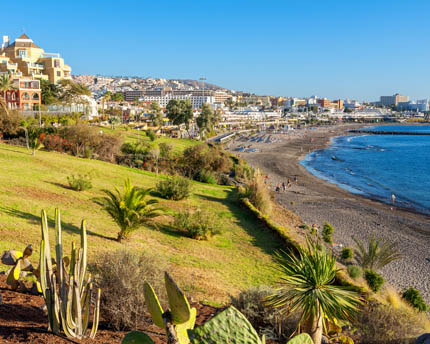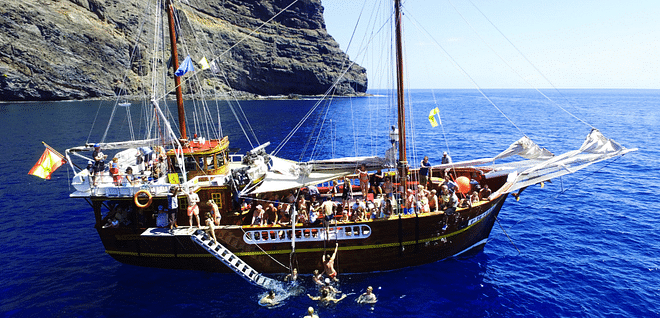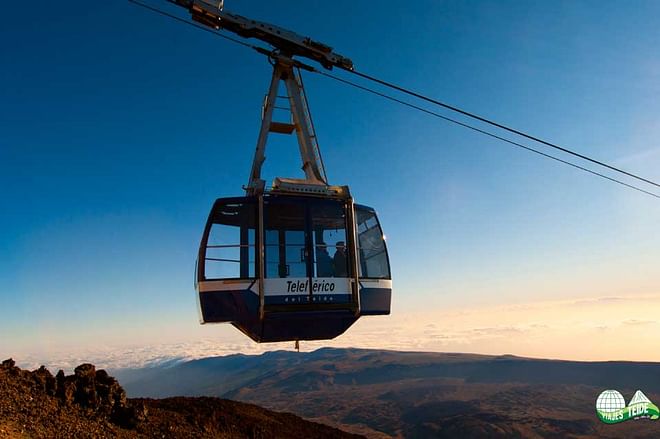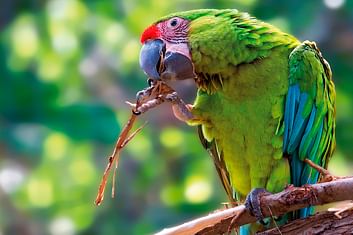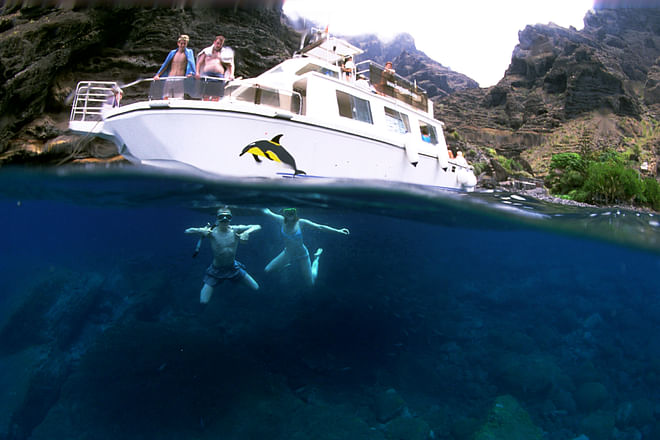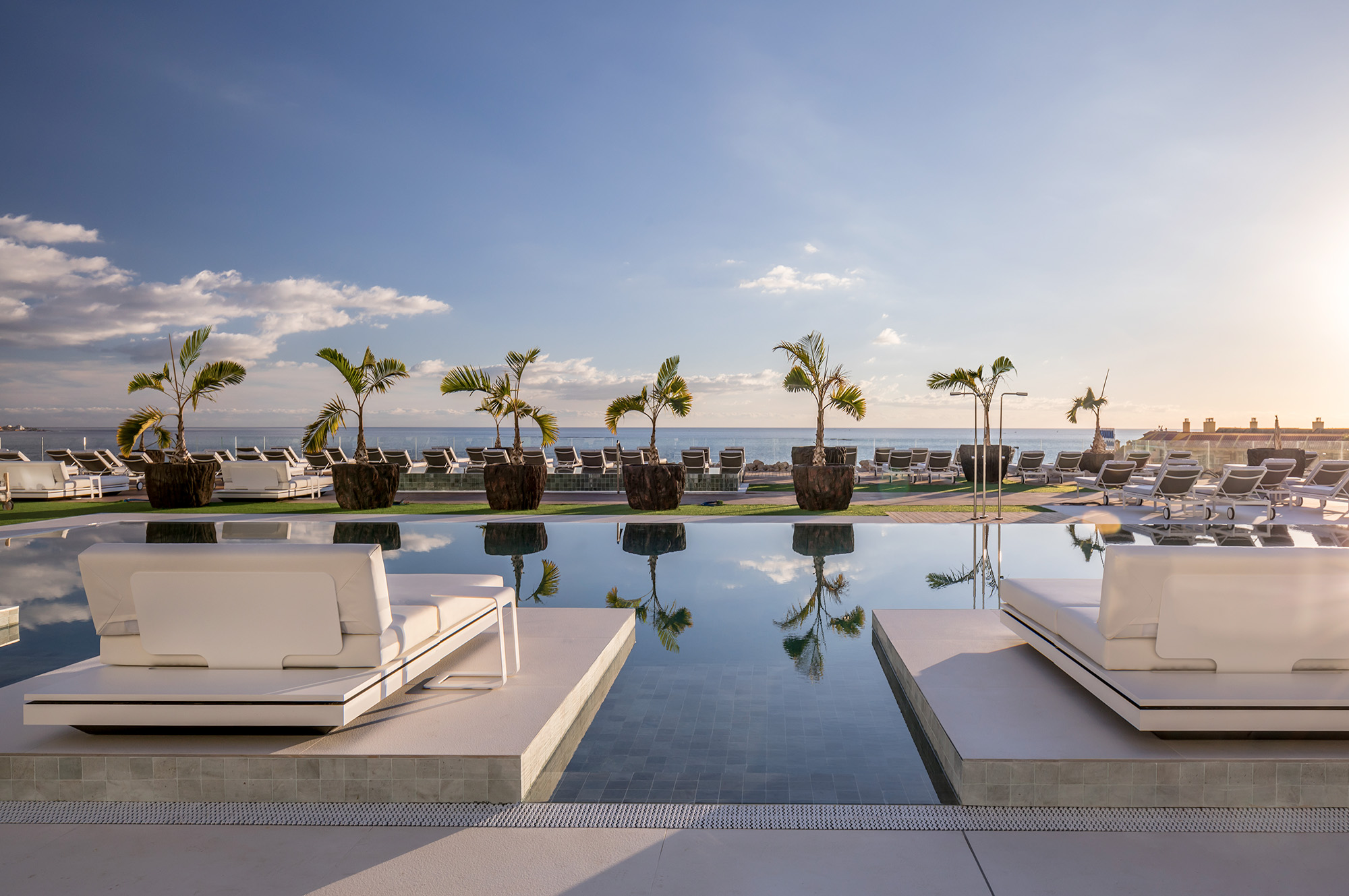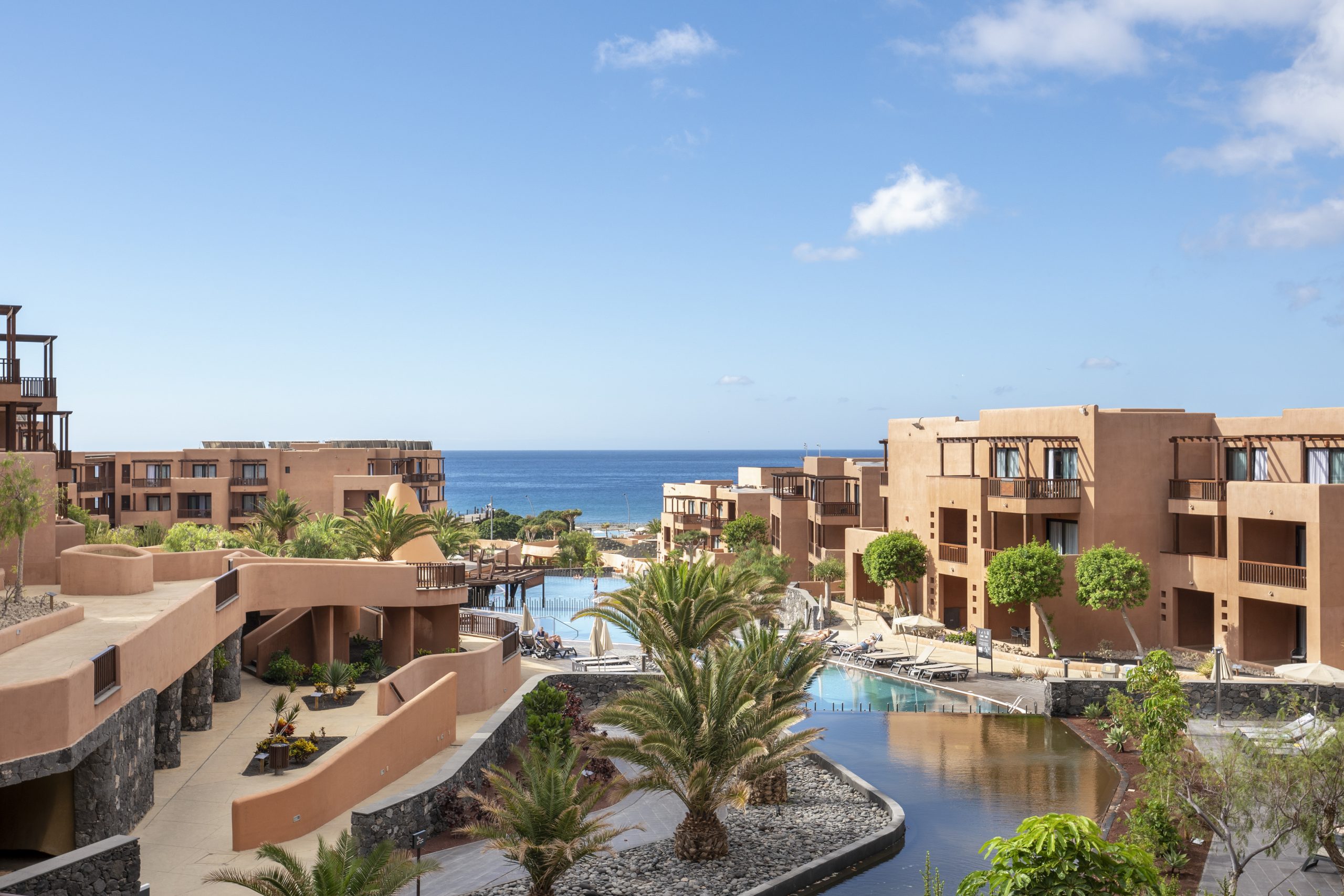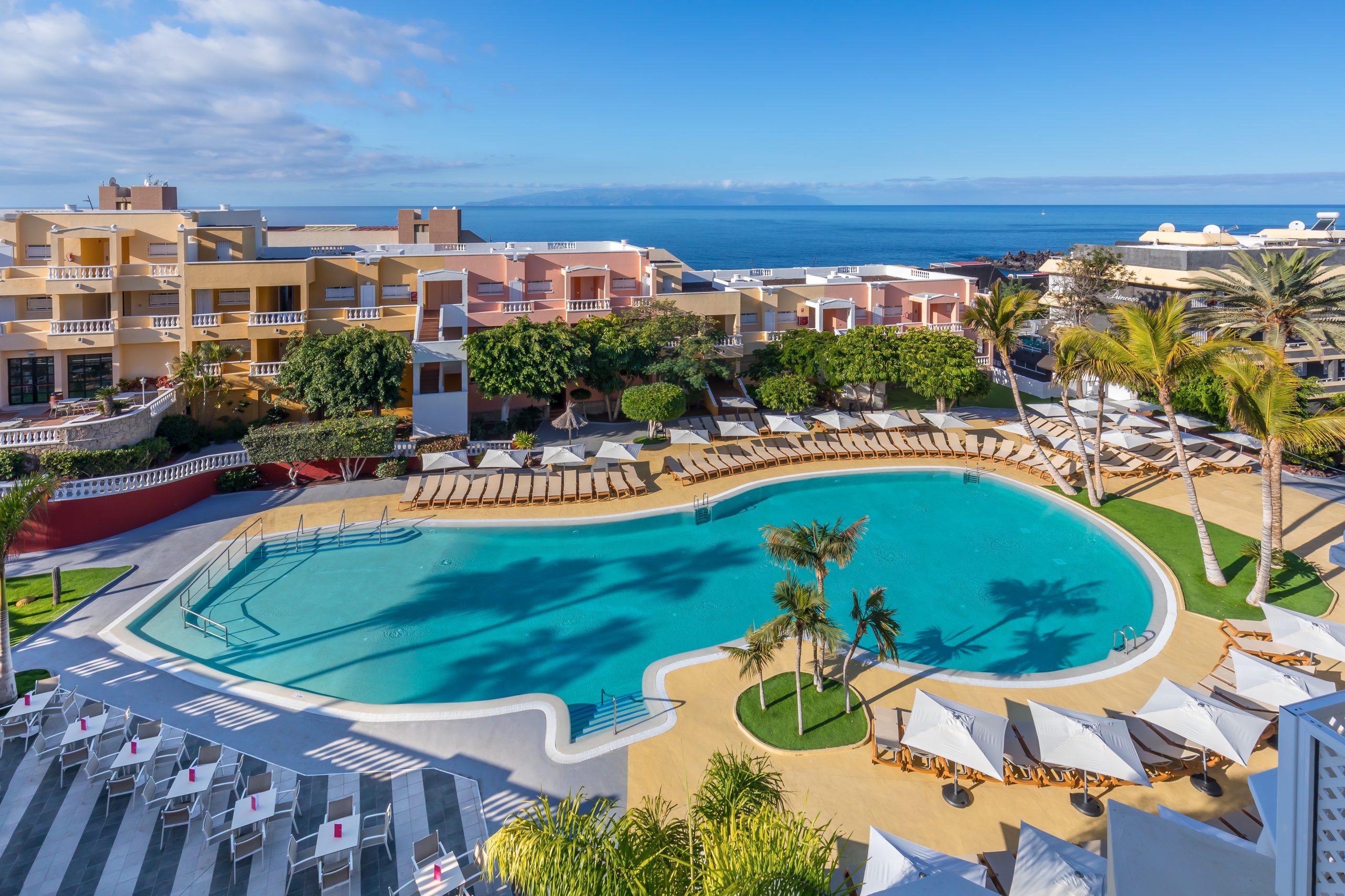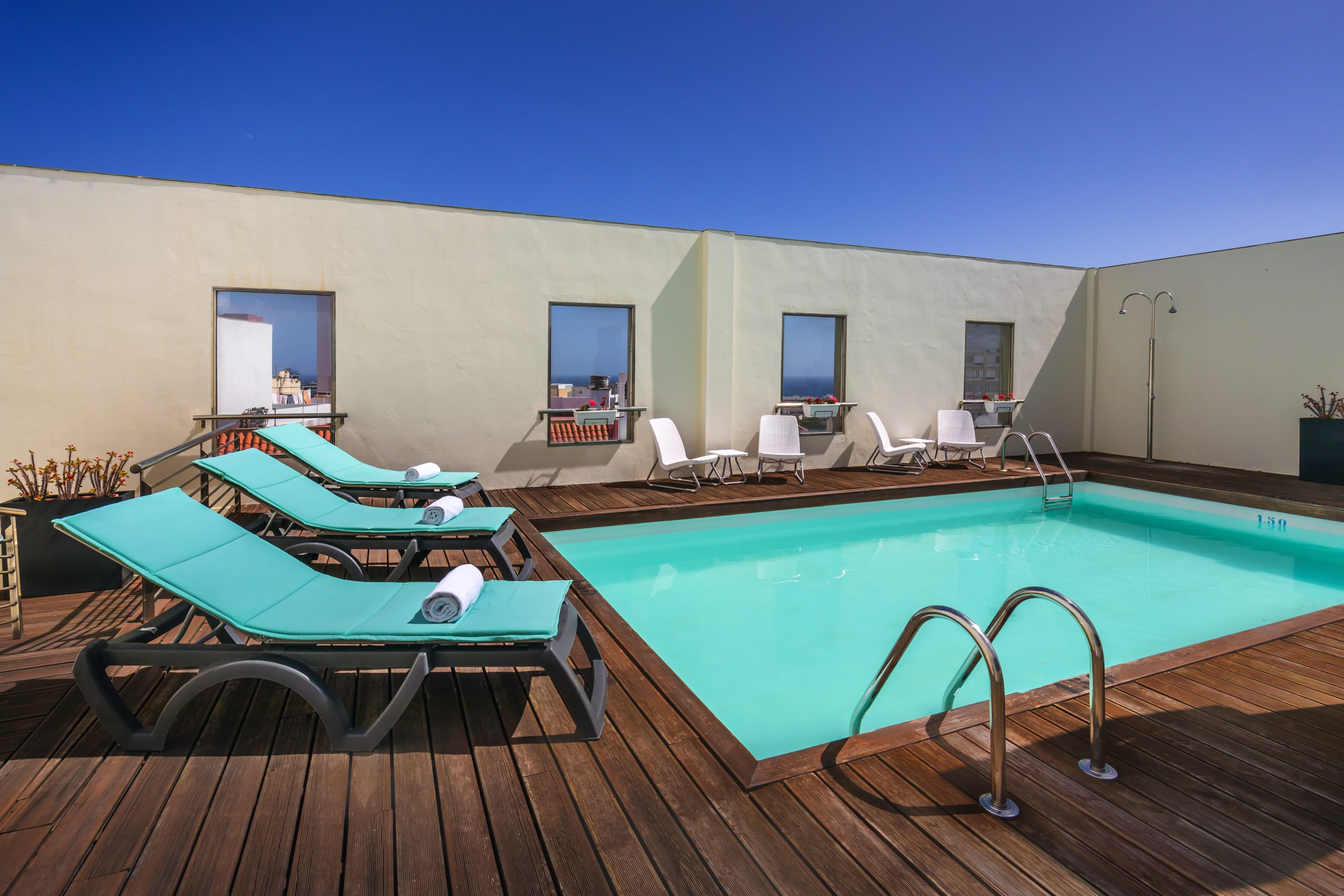It is said that Tenerife has a little of each of the Canary Islands. This fascinating island in the Atlantic ocean boasts a variety of landscapes and climates. Mount Teide, at 3,718 metres high, is a huge giant of nature that dominates the island. The famous volcano is the heart of this island full of contrasts. In the winter months, its snow-clad contours are a source of surprise to tourists bathing in the sea.
The natural beauty of the island of Tenerife astonishes travellers. The same is true of the other Canary Islands, such as Gran Canaria, Lanzarote and Fuerteventura. Areas of lush vegetation thrive side by side with arid areas. The island has beaches of volcanic rock, black sand and strong waves, but it also has other, gentler beaches with golden sands. And then there is the charm of Tenerife’s delightful towns and villages. Cities such as Santa Cruz de Tenerife, Puerto de la Cruz and San Cristóbal de la Laguna offer interesting options for both leisure and culture. Everything here, on the largest and most populated island in the Canary archipelago, invites you to enjoy your visit exploring the huge variety of activities on offer.
- Places you must see in Tenerife
- The Teide National Park
- El Barranco del Infierno, [Hell’s Gorge], a remarkable expedition
- El Drago Milenario [Millennian Dragon Tree]
- Cueva del Viento [Cave of Wind]
- Los Gigantes, a spectacular sight
- Parque Rural de Anaga [The Anaga Rural Park]
- Pyramids of Güímar
- Loro Park, a surprise at every turn
- Tenerife Carnival
- Tenerife’s most picturesque towns and villages
- Santa Cruz de Tenerife, a city made for leisurely meandering
- Puerto de la Cruz, the tourist capital of the North
- San Cristóbal de La Laguna, a university city
- Los Cristianos, a popular tourist destination
- La Orotava, town of balconies
- Adeje and Costa Adeje, myriad attractions
- Icod de los Vinos, in the shade of the Millennial Dragon Tree
- The best places to go bathing in Tenerife
1. PLACES YOU MUST SEE IN TENERIFE
The Teide National Park
When the French poet André Breton climbed to the summit of Mount Teide in 1935, he did not hesitate to describe Tenerife as the ‘surrealistic island’. The weird shapes formed by the lava fascinated the father of Surrealism. He immersed himself in the mystical qualities of the place, the native plant species, and the sea of cloud seen on the descent from Las Cañadas — and fell in love with it. It is difficult not to be similarly affected by such an extreme, astounding landscape.
Reaching a height of 3,718 metres, Mount Teide is the roof of Spain, and the third largest volcanic structure in the world. Its majestic presence dominates the entire island. And on clear days, it can be seen from other islands in the archipelago. Locals returning home after a time away are always overjoyed to see it again. Travellers to the island store its image in their memory. It is one of those corners of the world where it seems possible to grasp the harmony with nature that humans long for.
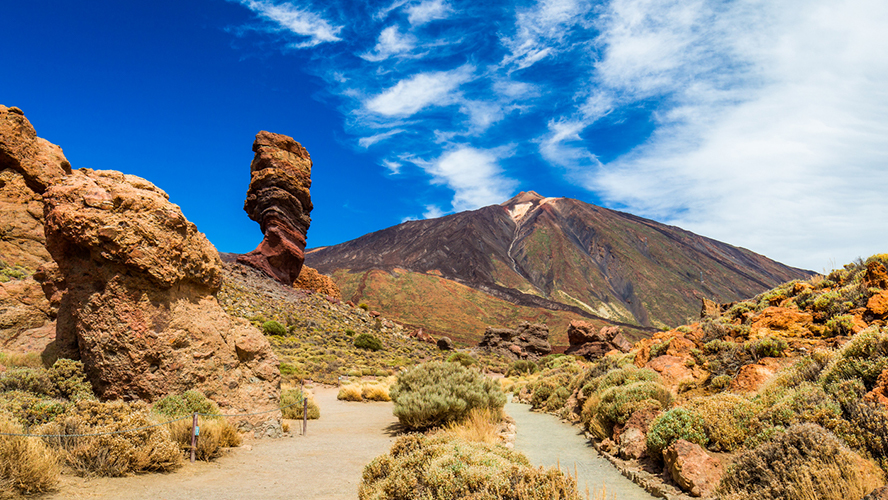
The beauty of Tenerife can be appreciated in full when you visit the Teide National Park. The Park was declared a World Heritage site by UNESCO in 2007. The mountain’s highest peak rises over the ancient Las Cañadas caldera. The Park covers 19,000 hectares, and includes outstanding volcanic formations such as Montaña Blanca and Pico Viejo (or Chahorra). These wild, sublime surroundings hold endless surprises. The different silhouettes and colours of the lava are a breathtaking spectacle. Lovers of botany can enjoy seeing plant species as remarkable as the red tajinaste, with its slender flower spikes. And, of course, there are cedar trees, pines and Canary Island willows. Walking enthusiasts have access to a varied network of paths. The ascent in the cable car (starting from the base of the volcano at 2,356 metres, and travelling up to La Rambleta at 3,555 metres) is a unique experience. You can climb from there up to the peak if you have obtained a special licence from the Park authorities. But it is a demanding climb, so it is only recommended for the most experienced and well-prepared walkers.
El Barranco del Infierno, a remarkable expedition
The Barranco del Infierno is a staggering sight. This is a beautiful landscape of great geological interest within the municipality of Adeje. Almost 50% of the land in Adeje is protected natural space. An outstanding example of such a space is the Barranco del Infierno Special Nature Reserve. The area offers a hike over deep gorges, waterfalls and caves that were once home to the Guanches, Tenerife’s original inhabitants. On this 6.5-kilometre walk (there and back), you can appreciate the different types of flora and fauna, enjoy breathtaking waterfalls, and admire the magnificent Caidero, a huge, 200-metre-high cascade formed by waters from the upper stretch of the river Roque Abinque.
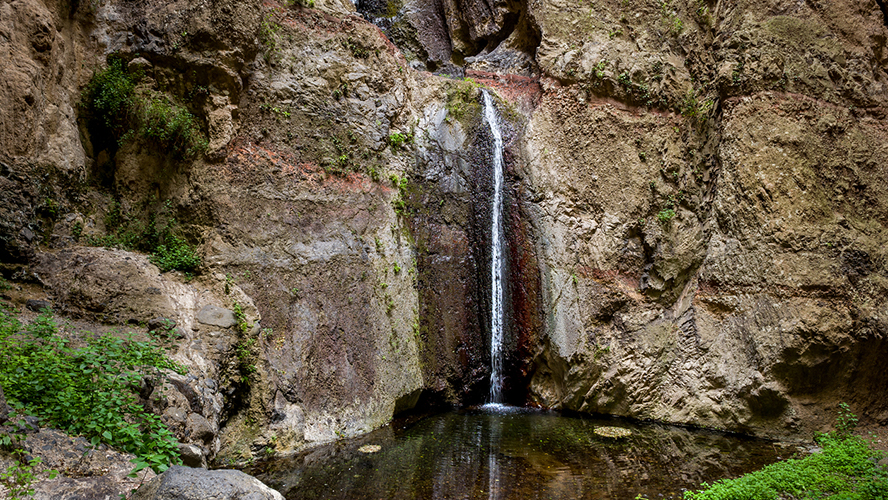
El Drago Milenario
One of Tenerife’s more unusual tourist attractions is a tree typically found in the Canary Islands: the dragon tree. But this is not just any dragon tree: this one is at least 800 years old, and is believed to be the oldest in the world. It stands in the town of Icod de los Vinos; is 18 metres tall and its trunk is over 20 metres in circumference. You can see it in the Plaza de la Constitución or, to get a better view, go into the Drago Milenario Park, where the paths are lined with other native species.
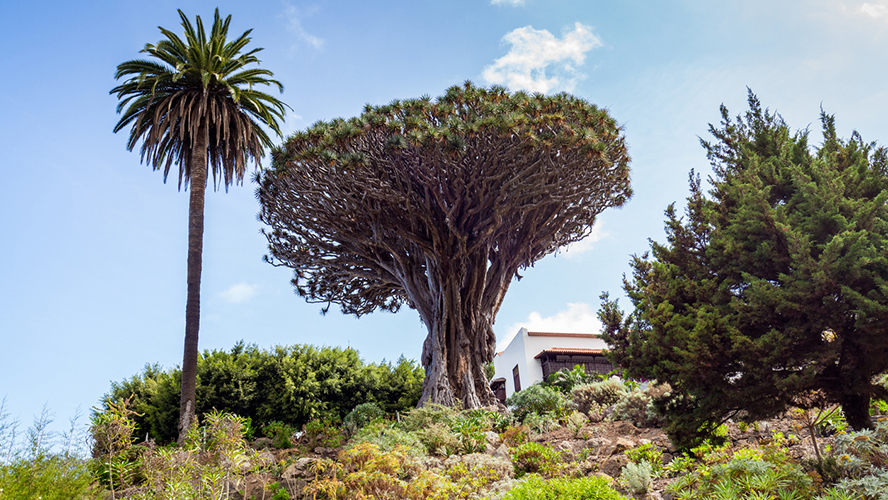
Cueva del Viento
Tenerife’s Cueva del Viento, also in Icod de los Vinos, is one of the island’s most impressive volcanic caves. Stretching back for 18 kilometres, it is one of the longest caves on the planet. When it was first discovered, in 1969, it was only possible to penetrate the first 6 kilometres. However, over time, successive explorations have revealed the full extent of the cave.
Inside can be seen different geomorphological formations and fossils. There are guided visits, and the tour is of moderate difficulty, but not recommended for children under the age of five, or people with mobility problems.
Los Gigantes, a spectacular sight
The cliffs of Los Gigantes are an incredible sight. Located on the western coast of Tenerife, most belong to the administrative districts of Buenavista del Norte and the others to Santiago del Teide, within the Teno Rural Park. The sheer, rocky walls of Los Gigantes rise majestically above the sea, reaching a height of 600 metres in places.
Getting to see them is not difficult, as there are countless opportunities to gaze on the majesty of the cliffs from out at sea (where they extend down to a depth of 30 metres) or on dry land, although access to the area of the cliffs themselves is necessarily restricted by the impenetrable nature of the formation. A boat trip is the best way to see this basalt wall of volcanic origin.
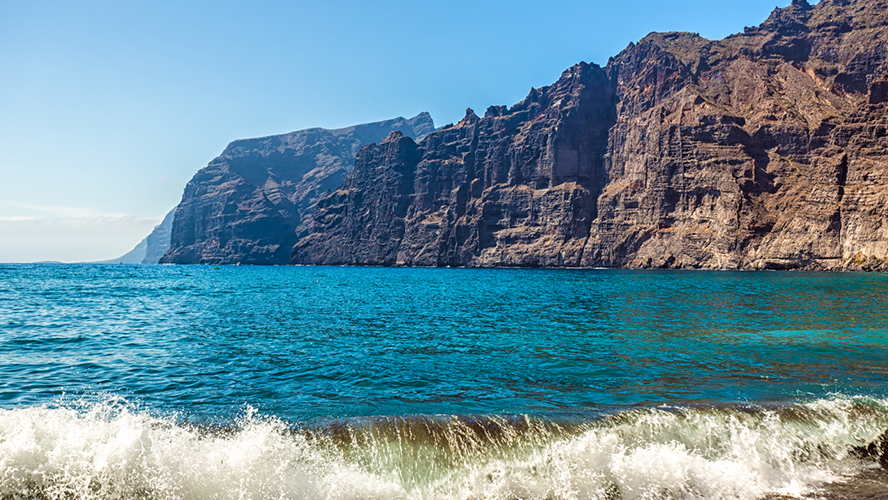
An alternative is to make your way to the Archipenque viewing point, on the main road between Tamaimo and Puerto de Santiago. From here, you can see the cliffs of Los Gigantes in all their magnificence. You can also see the tourist resort that bears their name, with its leisure marina; the Punta de Teno lighthouse, and even the island of La Gomera. At the foot of Los Gigantes lies the beach of the same name. It is a genuine pleasure to stroll along its dark-coloured shore, to bathe in its calm waters and to admire the views.
Parque Rural de Anaga
Anaga is the name of the mountain range that spans north-eastern Tenerife. In this area, which is a paradise for hikers, there is so much to explore. The Park was declared a Biosphere Reserve by UNESCO in 2015. Before that, it was a Rural Park. Along with Teide Natural Park, it is the island’s great natural treasure.
The massif has an average height of around 850 metres above sea level, and extends over the municipalities of Santa Cruz de Tenerife, San Cristóbal de La Laguna, and Tegueste. The average height of the rocks that form it do not exceed 1,000 metres, but between them there are gullies up to 300 metres in depth. In these depressions grow laurel forests, which are home to many plant and animal species.
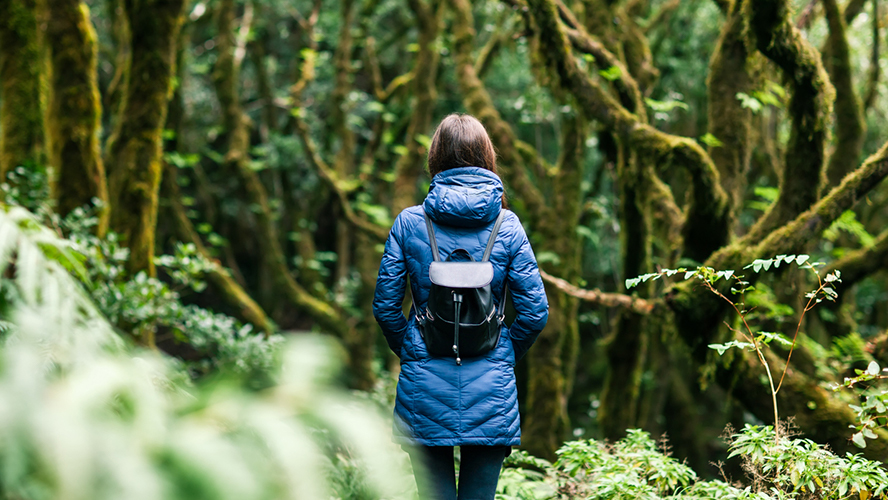
Various hiking trails cross the area, of different lengths and levels of difficulty. The best-known path is the so-called Bosque encantado [Enchanted Forest]. This takes you into what is known as the Reserva Natural Integral de El Pijaral, which covers around 300 hectares. Here you will find one of the largest concentrations of ferns in the Canary Islands, with many different species. Among them is Píjara, the fern that gave this place its name, and whose leaves can grow up to three metres in length.
If you want to know more about the unique Anaga Rural Park, you really need to stop off at the Visitor Centre, the Centro de Visitantes de la Cruz del Carmen. One of Tenerife’s most spectacular and unforgettable beaches, Benijo beach, is to be found in the Anaga area. It belongs to the delightful town of Taganana, in the hamlet from which the beach takes its name. The beach lies between two rocks, and is reached via a stepped path.
Pyramids of Güímar
The Güímar Pyramids Ethnographic Park and Botanical Gardens, is an attraction covering over 64,000 m2 in Tenerife, and to which Thor Heyerdahl dedicated a great deal of work. At the beginning of the 1990s, the renowned explorer took up the cause of protecting several stepped pyramids that had been found here. He saved them from destruction, or from being integrated somehow into an urban development.
The origins of the Pyramids of Güímar are uncertain; some attribute them to ancient civilizations, while others believe they are mounds created by farmers. Be that as it may, today this complex is open to the public, and includes a museum, a garden with poisonous plant species, an auditorium, and more. This is a perfect excursion from Santa Cruz de Tenerife, a mere 28 kilometres away.
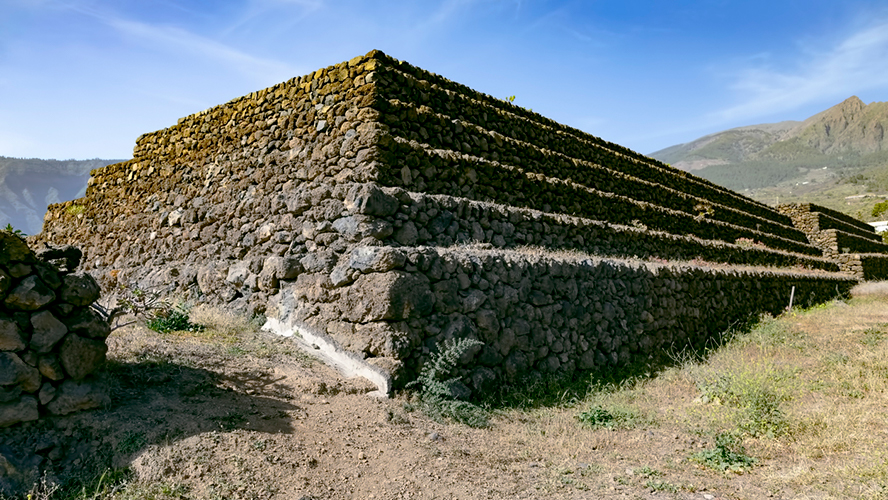
Loro Parque, a surprise at every turn
Loro Parque is very near to Playa Jardín, in Puerto de la Cruz. The park, which covers an area of 135,000 m2, is one of the most popular attractions in the Canary archipelago. Tourists from all over the world come to see the world’s largest and most diverse parrot reserve. But these tropical gardens are home to many other species too. Adults and children alike are fascinated by the animal and exotic plant life here.
Named several times by Tripadvisor as ‘Best Zoo in the World’, Loro Parque offers the chance to get a close-up look at its huge family of parrots. But you can also see lions, tigers, hippopotamuses, killer whales, sea lions, penguins, flamingos, sharks, alligators and turtles. All the animals live in spaces that replicate their natural habitats.
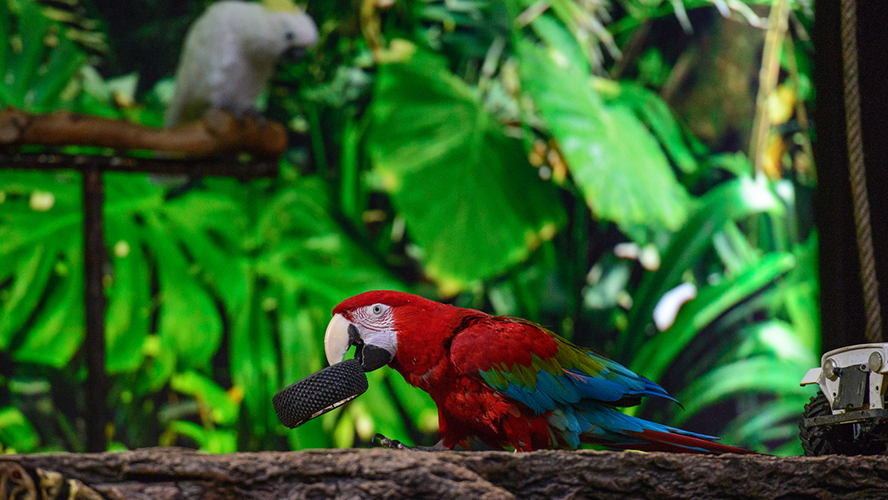
The penguin park Planet Penguin is the largest in the world, and is an outstanding attraction. It is an amazing slice of the Antarctic Ocean transported to the mild climate of Tenerife. But Loro Parque has many other areas that captivate visitors. Here, there is a surprise around every corner. And the zoo helps to build love and empathy for the animal kingdom. This certainly happens when you watch the park’s birds in the Loro Show, a pioneering event in Europe. It also happens when you see the killer whales and the sea lions. And the dolphins, which are so endearing performing their tricks and capers in front of a spellbound audience.
It is also worth seeing the area called Katandra Treetops, the setting for one of the world’s most fabulous free-flight aviaries. Here, hundreds of tropical birds fly over the heads of visitors and squawk and chatter around them. In this corner of the park, you will feel that you have been transported to a South American tropical rainforest. In other parts, it feels like you are in a jungle or enjoying the harmony of a genuine zen garden. This park, which stands out thanks to its initiatives to protect the environment and to conserve species, has so many wonderful attractions.
Tenerife Carnival
Tenerife’s most colourful and international festival is its CARNIVAL, which well deserves be written in capitals, given its importance to the entire population of the island. It even enjoys the status of being a Festival of International Tourist Interest. Although this festival can only be properly appreciated by actually seeing it in person, we can give you a few details to help you before you set off.
Tenerife Carnival has three events that you really shouldn’t miss: the gala to select the Carnival Queen, where contestants compete in terms of glamour and imaginative costume to achieve a place of honour; the Cabalgata [Procession], in which the people take part in their finest costumes; and the Coso, the grand procession along the seafront, with carnival queens and their maids of honour, floats and music groups. A spectacular climax, and not to be missed if you want a great time.
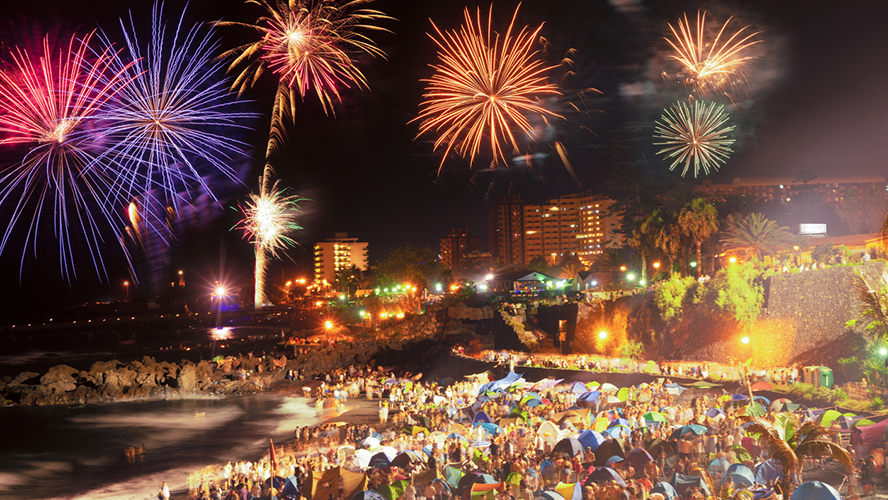
2. TENERIFE’S MOST PICTURESQUE TOWNS AND VILLAGES
Santa Cruz de Tenerife, a city made for leisurely strolling
Santa Cruz de Tenerife, the island’s capital, with its dignified air, is welcoming and friendly towards visitors. Among the city’s attractions are the Barranco de Santos, and the Cordillera de Anaga, with their traditional, colourful cottages and, of course, their seafronts. The city centre is easily covered on foot, and everywhere — the parks, squares and landscaped areas — seem designed with strolling in mind. There are so many delightful spots to discover in Santa Cruz.
To get a real feeling for the city’s atmosphere, Plaza de España is the place you need to make for. This is where the locals gather to socialise, at the terraces around the square. The area has been remodelled in accordance with a design by the Swiss architects Herzog and De Meuron. And the stars of the project are an impressive lake and a geyser, almost 30 metres in height.
Calle del Castillo, one of the city’s main shopping thoroughfares, is another tourist attraction. From here, you can reach other well-known pedestrian areas as well as delightful little passageways and narrow streets. It is well worth visiting the Toscal neighbourhood, a district steeped in character. And you may also enjoy a walk around the stately Ramblas. This boulevard leading down to the sea is lined with impressive colonial-style mansions. It has many quiet terraces and outdoor sculptures.
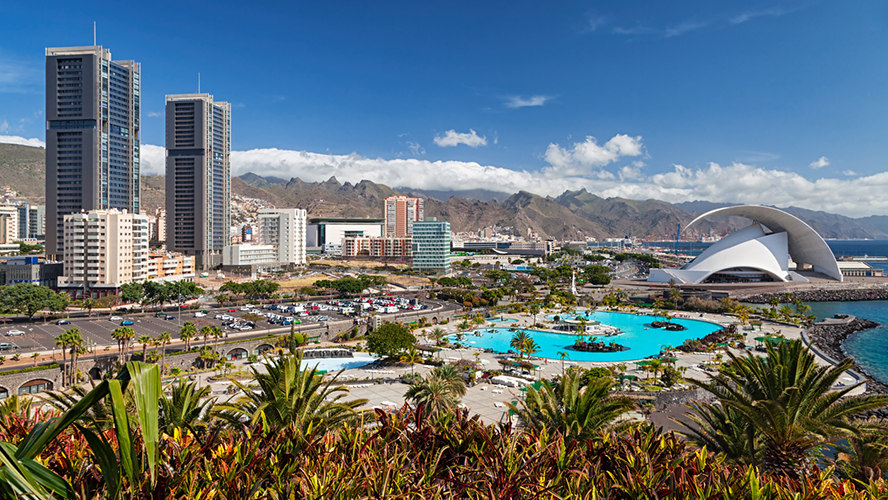
One of the city’s most outstanding squares is the Plaza del Príncipe, with its traditional central kiosk. This is where the locals meet up for a drink at one of the terraces. Among the city’s many parks, García Sanabria is one worth visiting. It features a clock created from flowers at its entrance, and its botanical garden is well stocked with lush vegetation. Santa Cruz also has some splendid museums. Lovers of modern art should not miss the TEA (Tenerife Espacio de las Artes) [Tenerife Arts Space]. The building, another designed by the renowned architects Herzog and De Meuron, is definitely worth seeing. Anyone who is interested in learning more about the island’s original inhabitants, the Guanches, should visit the Museo de la Naturaleza y la Arqueología.
Other enjoyable things you can do in Santa Cruz de Tenerife are: going for a stroll around the port area; Going for a swim at the beach of Las Teresitas or in the swimming pools at the Parque Marítimo César Manrique; Visiting the market, the Mercado Nuestra Señora de África; Attending a concert in the ultra-modern Auditorio de Calatrava; And the simplest approach of all: just allow yourself to appreciate the beauty of the trees and flowers on every corner. The lovely royal poinciana trees, the magnolias, oleanders, among others.
Puerto de la Cruz, the tourist capital of the North
Puerto de la Cruz is the tourist capital of the North of Tenerife. And one of the first places in Spain to attract visitors on a grand scale. English travellers discovered the city in the mid nineteenth century. The visit by Agatha Christie in 1927 has gone down in history. The writer came to this beautiful part of Tenerife to recover from her divorce and the death of her mother. She stayed in the old Hotel Taoro, and wrote two of her books there. In one of them, The Mysterious Mr. Quin, she depicts some of the city’s most emblematic spots. The name of the lady who is a character in this story has gone down in the history of Puerto de la Cruz. A statue of her can be seen in the La Paz viewing point.
Many of the attractions that so captivated the English writer still remain intact. If you visit the little fishing port, you can take a very pleasant walk along the avenue that borders the seafront. One star attraction in this area is the Lago Martiánez complex. Designed by the Canary Island artist César Manrique, this installation covers an area of 100,000 m2. Inside are seven swimming pools filled with sea water. There is also a large central lake containing five islands, along with gardens, terraces, viewing points, and sculptures. Manrique’s artistry shines through in the exotic character of the complex. Spending a day here is a brilliant plan. There are bars and restaurants for visitors to enjoy. And the complex even has a disco.
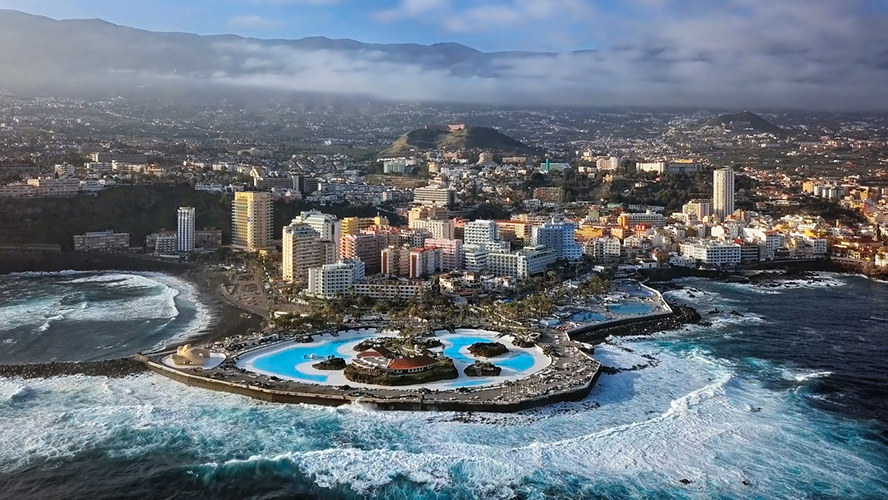
For those who prefer the beach, Puerto de la Cruz offers the beaches of San Telmo, El Muelle, Martiánez, and Jardín. Playa Jardín is a 700-metre-long stretch of black sand, and is the most tourist orientated, as it offers a wide range of service to bathers.
Away from the coast, at the highest point of the city, lies one of Puerto de la Cruz’s undisputed treasures, its Botanical Gardens. Located in Calle de la Retama, it was built on the orders of Carlos III in 1788. It contains some very old specimens, including a 150-year-old mamey. Other trees to be found here are of a colossal size, such as the well-known Lord Howe fig tree, which measures 40 metres in diameter.
The popular Plaza del Charco, Castillo de San Felipe (now a cultural centre) and the historic Casa de Aduana [Customs House], Casa de Tomás Iriarte and Casa Franchy, are other attractions open to visitors in Puerto de la Cruz.
San Cristóbal de La Laguna, a university city
The best way to travel to La Laguna is by the tram service that departs from Santa Cruz. Or the other way around. The two cities are close together, and complement each other. La Laguna is a university city with an aristocratic, colonial ambience. Large mansions stand alongside more modest houses with highly colourful doors and windows. It is worth going for a stroll around the city’s main streets: San Agustín, Obispo Rey Redondo, and the most commercial street, Herradores.
In La Laguna’s historic quarter, which was declared a Cultural Asset and a World Heritage Site by UNESCO in 1999, time really seems to have stood still. As you walk around the city, you will be able to pick out the features of Canary Island architecture. And you will marvel at these beautiful buildings steeped in history. You will feel as if you have been transported back to the fifteenth and sixteenth centuries as you gaze at these magnificent edifices, including the Casa de la Alhóndiga, the Casa de los Capitanes Generales, the Casa del Corregidor, Casa Osuna and the simpler Casa Granero.
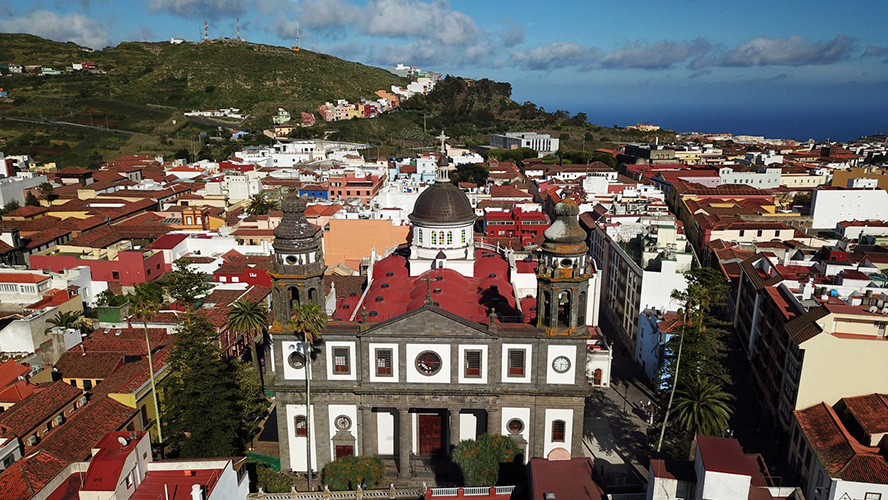
Every visitor to La Laguna should see the Cathedral, which stands in Plaza de los Remedios, as well as the Convent of San Agustín and the church known as the Iglesia de la Concepción. Then when you need a rest, direct your steps towards Plaza del Adelantado. This square is very near the Town Hall, the Municipal Market and the Hermitage of San Miguel Arcángel. It is a popular social meeting place for the locals.
The Museum of History and Anthropology is also worth a visit; it is housed in the lovely Lercaro Palace. Then there’s Fundación Cristino de Vera. Here, the aura of mysticism that characterises this Canary Island artist’s work seems to permeate the whole atmosphere of the building. The city has an abundance of charming little squares, streets, and secret magical nooks and crannies waiting to be explored.
A harmonious coexistence prevails between La Laguna’s stately past and its current function as a university city. The prestigious University of La Laguna contributes to the city’s rich cultural climate. There are very well-known writers’ haunts, such as as El Ateneo. And theatres with an illustrious tradition, such as the Leal. And lots of taverns, restaurants and bars where visitors can enjoy spending an hour or two. The nightlife here is vibrant, as in any student city. Past and present, ancient and modern, all co-exist in harmony in this corner of north-west Tenerife.
Los Cristianos, a popular tourist destination
Los Cristianos is another of southern Tenerife’s most popular tourist resorts. The beach of the same name is characterised by the brilliantly colourful boats anchored there. The beach has always been much loved by families living on the island, as has the beach of Las Vistas. The latter is much longer, stretching for almost a kilometre, and has shallow waters.
Once upon a time, Los Cristianos was a fishing village. The centre expanded to accommodate the growing numbers of tourists, but here and there it still retains something of its original seafaring character. The heart of Los Cristianos is its pedestrianised promenade which runs alongside the beaches, packed with bars, restaurants and snack bars. In the evening, its lively atmosphere puts it on a par with Las Americas in terms of nightlife.
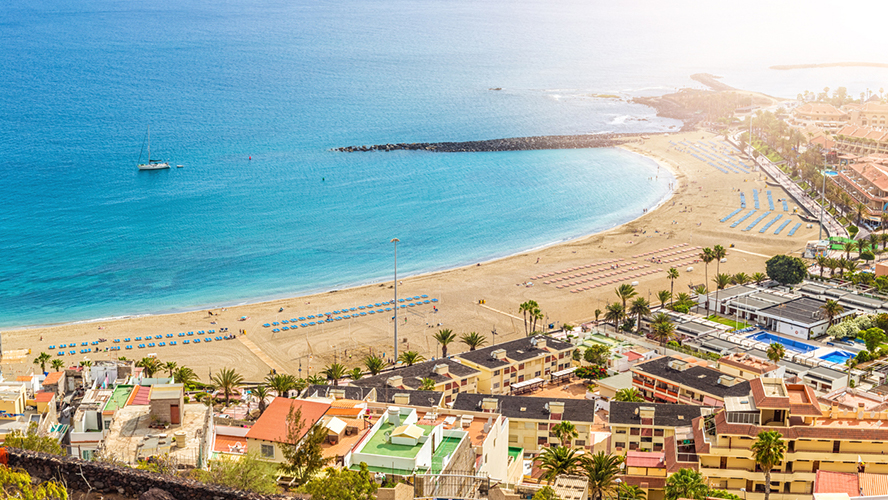
Another popular social hub is the port area, Puerto de Los Cristianos. It lies to the west of South Tenerife Reina Sofia Airport. From the port, visitors can take fishing trips, cetacean-spotting excursions and diving trips. Also from here, the ferries depart for the neighbouring islands of La Gomera, La Palma and El Hierro. The nearest attractions include Monkey Park zoo and Aqualand.
La Orotava, town of balconies
La Orotava is an exquisite town in Northern Tenerife. It is always a great pleasure to walk along its cobbled streets, admiring its old mansions. The town’s famous wooden balconies, so typical of Canary Island architecture, are an undisputed symbol of La Orotava’s identity. There are many churches worth visiting in this corner of Tenerife, which transports the traveller back in time to the conquest of the island, during the reign of Spain’s Catholic monarchs.
During the festival of Corpus Christi, local people make carpets of flowers. They cover the pavements, and are famous for their combination of petals and volcanic sand. This is a perfect time to take a leisurely walk around the town, but at any time of the year this is a spellbinding place to visit.
La Orotava’s historic quarter, which has been declared a National Historic-Artistic Site, has been remarkably successful in preserving its historic buildings. Here, just as in La Laguna, time seems to have stood still. Among the many places of interest, the Iglesia de la Concepción is one you should not miss. This is a splendid edifice, with its Baroque façade, original towers and majestic cupola. Inside you will find important religious pieces dating from the sixteenth and seventeenth centuries.
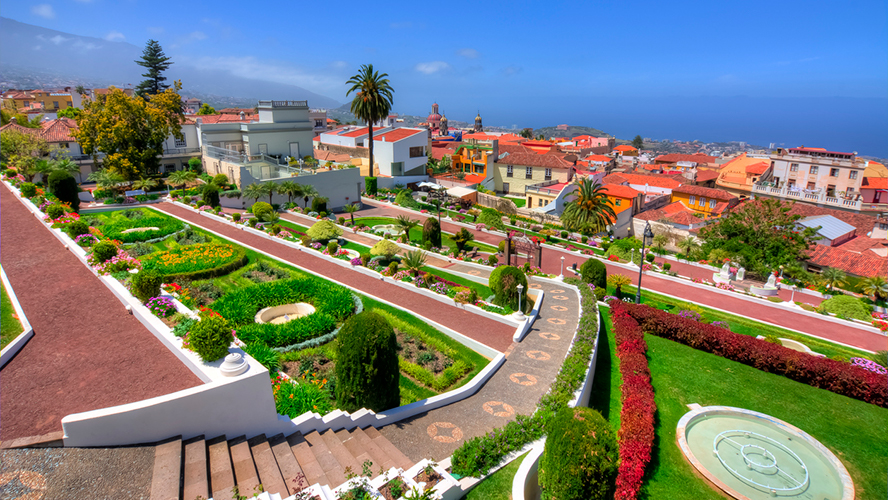
Another of the town’s most famous buildings is the Casa de los Balcones [House of Balconies], a remarkable, traditional mansion which is now home to the Centro de Investigación de Artesanía de Europa y América [European and American Centre for Research into Crafts]. The complex, built during the sixteenth and seventeenth centuries, has magnificent balconies (hence its name), and an inner courtyard of carved wood.
It is very pleasurable to spend some time wandering in the peaceful, relaxing Victoria de la Orotava Gardens. They are also known as the Marquesado de la Quinta Roja Gardens. They were designed by the French artist Adolph Coquet in the nineteenth century. They have a very unusual structure, set out in tiered terraces. They have a large number of beautiful fountains, set among brightly-coloured flowers. From the highest point of the gardens, visitors can enjoy impressive views over the island.
Adeje and Costa Adeje, myriad attractions
Costa Adeje’s star attractions are its beaches, its water parks, and the opportunity to play golf, go diving or go cetacean spotting. But it is also worth venturing into the town that has given its name to the tourist resort. This town on the south of the island has an interesting historical heritage. It also boasts natural spaces that are sure to impress, including the Barranco del Infierno [Hell’s Gorge]and the Caldera del Rey.
So there are endless attractions that lead people to choose Adeje as their holiday destination. Along 26 kilometres of coastline, there are 14 beaches and coves. Tourists can opt for large, busy bathing areas, such as Playa del Duque, Playa de Fañabé, Playa de Torviscas, or Playa de la Pinta. But the coastline also offers more isolated, peaceful spots, including Playa Los Morteros and Las Salinas.
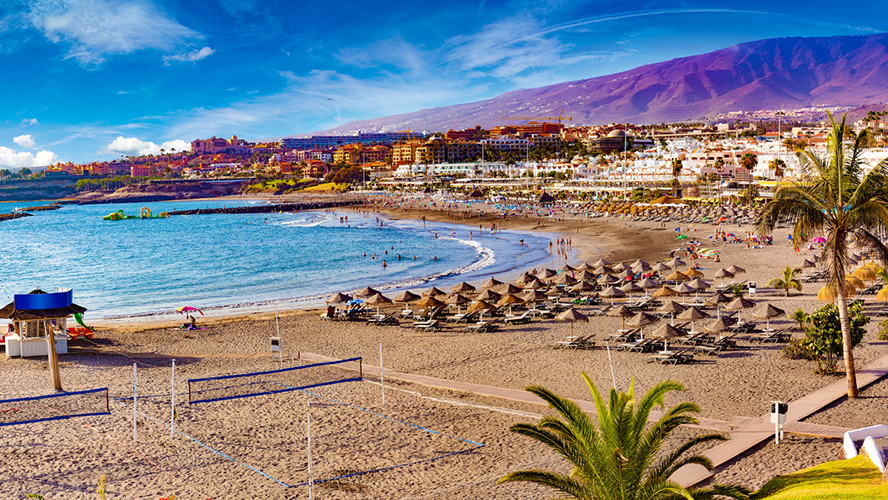
The choice of hotels and apartments (and of places to eat) along Costa Adeje is enormous. Like its neighbour Las Américas, it offers a packed programme of sport and leisure options. One highlight is Siam Park, an impressive water park that is sure to delight children and adults alike. The opportunities for diving are also one of the area’s great attractions. Its lovely coastline, home to over 500 species of fish and other sea creatures, attracts thousands of visitors to its many diving centres.
Villa de Adeje has a long history dating back to the times before the Christian conquest, when the island was dominated by the Guanches. For that reason, the area has a fascinating historic and artistic heritage. Among the most appealing monuments is the Church of Santa Úrsula. This was built on the site of a primitive sixteenth-century hermitage. Also intriguing are the ruins of Casa Fuerte, a fortified dwelling at the entrance to the town, built to defend it against the frequent pirate attacks.
Icod de los Vinos, in the shade of the millennial Dragon Tree
Icod de los Vinos is a small town in the North of the island, famous for its Millennial Dragon tree, the world’s oldest known tree. It is 17 metres tall, and its trunk weighs 65 tonnes. It has stood up well to the passage of time, and resembles a kind of natural sculpture which everyone is keen to visit. A park has been built around this legendary tree with other plant species native to the island. It is this area’s main attraction.
But there is much more to see in Icod de los Vinos, a place known for its excellent soups. Its monuments include the magnificent Convent of San Francisco. Dating from the seventeenth-century, and built in the Portuguese rococo style, it includes the remarkable Chapel of Los Dolores. And the late eighteenth-century, neoclassical Casa Lorenzo-Cáceres. Nowadays, this is used as a Music Centre, and an exhibition space.
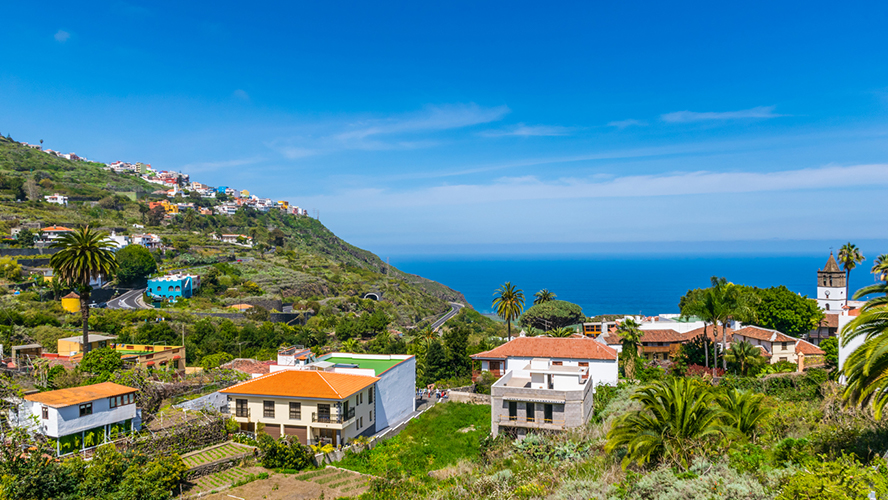
In the town itself, the Guanche Museum makes for an interesting visit. As does the Mariposario [butterfly park], home to over 800 tropical butterflies, from around 150 different species. It is important, too, not to forget the Cueva del Viento. This is a huge volcanic tube formed around 27,000 years ago. Within it live approximately 190 species of plants, animals and fungi.
3. THE BEST PLACES TO BATHE AND SWIM IN TENERIFE
El Médano and its surfers’ beach
El Médano, in the municipality of Granadilla de Abona, is another popular tourism hub in southern Tenerife. This stretch of coastline has a distinct character, with its wild, bleak appearance. Here you will find Médano beach, one of the island’s longest beaches, and a genuine surfers’ paradise along those stretches where the swell is at its strongest. This is the area’s best-known beach, but you could also go for a swim off coves such as El Cabezo, El Salado and La Jaquita.
Further away from the town, and also more rugged, is the beautiful Montaña Roja beach, just at the foot of the volcano, and the beach of Tejita, the most remote beach of all, separated from the rest by the imposing bulk of the mountain. The beach is dominated by the imposing silhouette of the Montaña Roja volcano. This 171-metre-high volcano is the visible part of a natural reserve covering 166 hectares, and inhabited by protected birds including the Kentish Plover. This particular species has disappeared from other coastal areas of the island, due to the changes in ecosystems caused by tourism. This is an ideal place to undertake simple hiking trails. Its peacefulness and the scenery is the reward that awaits any traveller who wants to leave behind the noise and bustle of the city.
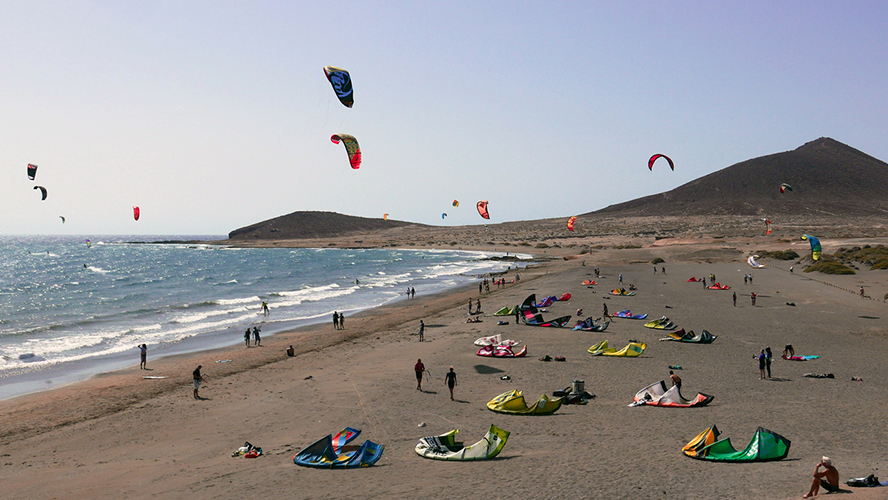
Los Realejos, history and nature
Los Realejos another of North Tenerife’s most stunningly beautiful areas. Here, the loveliness of the scenery is combined with a rich historic and artistic heritage. It is 41 kilometres from the capital city, in the midst of the fertile Valle de la Orotava. A good part of the area’s 57 square kilometres is protected by various environmental laws. And its two historic quarters (Realejo Alto and Realejo Bajo — which merged in the mid-twentieth century) hold the status of Assets of Cultural Interest.
In the town’s network of steeply climbing streets, visitors will stumble across many points of interest. In Realejo Alto, the town centre located furthest from the coast, stands the house where the writer Viera y Clavijo was born in 1731. Nowadays, the building houses the town’s public library. This famous house shares the square with the Iglesia Matriz de Santiago Apóstol.
And in Realejo Bajo, you will find another architectural jewel, the Hacienda de los Príncipes. It was built in the fifteenth century by the first governor of Tenerife, Alonso Fernández de Lugo. Around it stand other interesting edifices, but if what you’re looking for is natural scenery, you will not be disappointed.
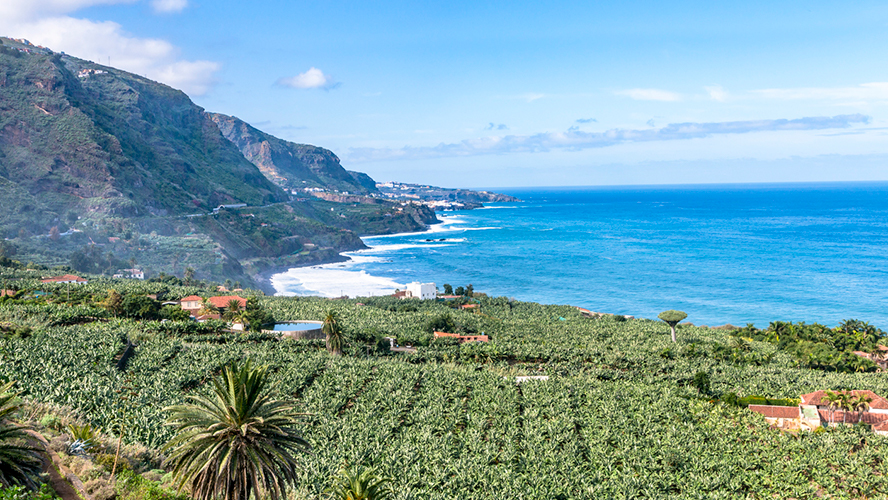
Attractive viewing points and wild beaches await you in this area. Playa del Socorro and Playa de la Fajana are both impressive beaches. And the protected area of Rambla de Castro is simply glorious. The area is well stocked with Canary Island palm trees, tabaibales and dragon trees.
Travelling down towards the sea, you will find the Hermitage of San Pedro, built on top of a cliff during the eighteenth century. Another surprising discovery is the Castro mansion, a former sixteenth-century farmstead, which has been converted into a visitor centre. Further down stands the Fortín de San Pedro a splendid example of a defensive fortress built to thwart attacks by pirates during the sixteenth and seventeenth centuries.
Playa de las Américas, fun beside the sea
Playa de las Américas lies between the municipalities of Arona and Adeje, in the south of Tenerife. The beach shares its name with the tourist resort as whole, a popular holiday destination with many Europeans on a quest for some sunshine during the cold winter months.
This is the ideal place if you are looking for fun, sport and entertainment for all the family.
Here the nights are for partying, but during the daytime the main attraction are the beaches with their golden sands and clear waters. Las Américas is the area’s longest beach, stretching for 500 metres. But along this one-kilometre coastal strip, there are alternatives, including the beaches of Troya, La Honda, and El Camisón, lying in the midst of green areas and palm trees.
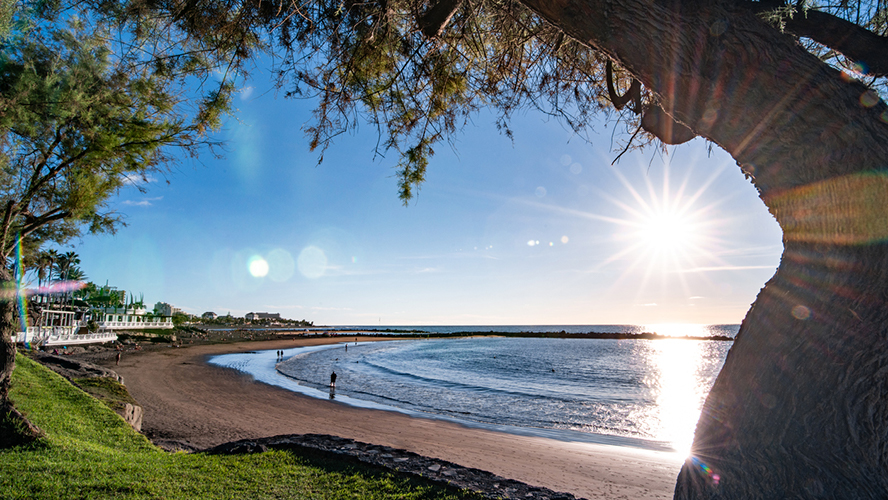
This corner of Tenerife offers an excellent range of hotels and places to eat, with shops and all kinds of services available to visitors. All this makes it a favourite destination for a holiday on the island. There is an enormous range of leisure options and water sports on offer here. These include water-skiing, windsurfing and diving. The area also has a golf course.
Las Teresitas
The beach of Las Teresitas, located just 7 kilometres from Santa Cruz de Tenerife, is a favourite among residents of the island’s capital city. This kilometre-long beach lies within the town of San Andrés. It is a man-made beach, created during the 1970s. Fine, white sand imported from the Sahara Desert was poured onto the original beach of volcanic sand.
Thanks to its calm waters, the beach is popular with families. In addition, very close to Las Teresitas you will find superb establishments where you can try local cuisine.
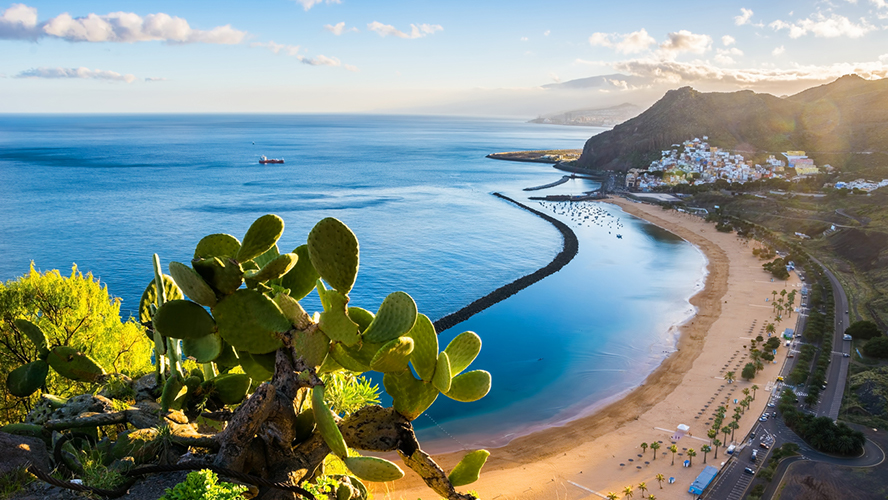
Other excellent beaches in Tenerife
Other beaches worth exploring in Tenerife include Benijo beach, in the little town of Taganana, whose rugged appearance will instantly capture your heart; Playa del Duque, on Costa Adeje, very near La Caleta, a quiet beach that can reached without straying too far from the tourist resorts, and Los Gigantes beach, in Santiago del Teide, which lies close to the magnificent Los Gigantes cliffs. If you visit Los Gigantes, we recommend that you combine your day at the beach with a cetacean-spotting boat trip.
There are other beaches that are less easy to access, such as Playa de Masca, in Buenavista del Norte, which is best reached from the sea; beaches perfect for surfing including Playa La Tejita, La Fajana or Rambla de Castro; and unspoilt, almost deserted beaches such as Bollullo, with its dark-coloured sands.
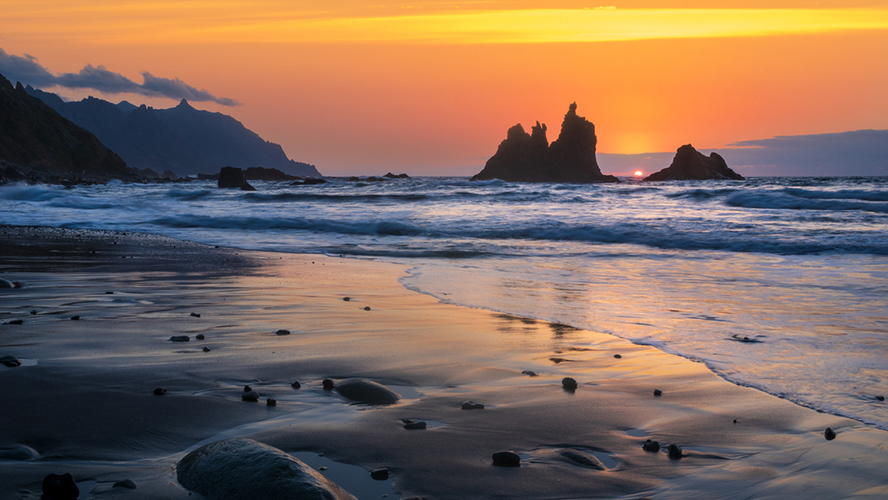
Tenerife has so many beaches that often, the best plan is to let yourself be led by instinct, or by the advice of local people if you want to discover the best.
Natural swimming pools in Tenerife
Every year, Instagram profiles are awash with photos of natural swimming pools set amid wild scenery and with limpid waters. As one might expect, Tenerife has a good number of these pools. Below, we have listed five of our favourites. Top of the list is El Caletón, in the town of Garachico. The natural swimming pools here were formed following the eruptions of the Trevejo volcano in 1706.
Charco de Isla Cangrejo, in Santiago del Teide, was created by building a concrete wall to protect the Isla Cangrejo residential development from the waves and tides. You will need to take care, as there is a powerful swell here.
Also very good for bathing are the Paseo La Jaquita natural swimming pools in Guía de Isora, which are also of volcanic origin, and which afford views of La Gomera. In San Cristóbal de La Laguna, the most popular natural swimming pools are those at Punta Hidalgo. These are large, and hold a blue flag, guaranteeing the quality of the water.
Lastly, the Charco Los Chochos, in the municipality of Los Silos, is less well known, but even has steps and a handrail for ease of access. The pool takes its name from the local people’s practice of soaking lupin seeds, commonly known as “chochos” here, to take away their bitterness.
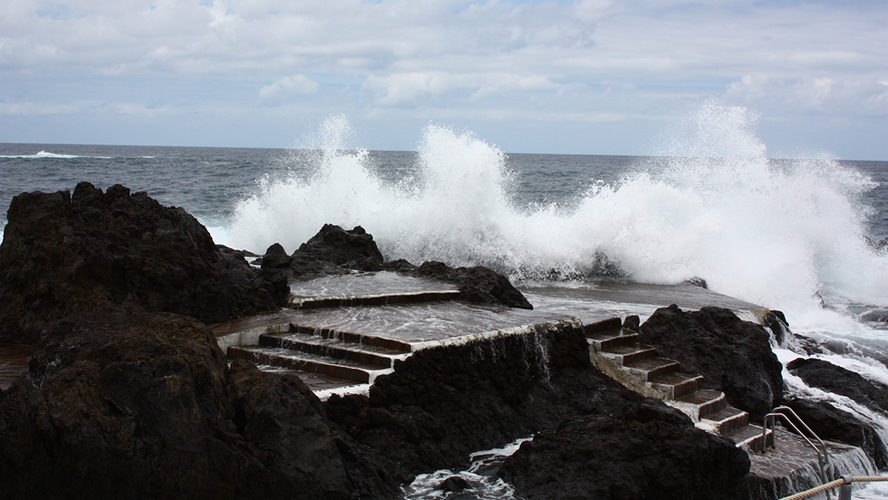
Lago Martiánez
Lago Martiánez is a leisure complex in Puerto de la Cruz, with facilities including an enormous artificial lake commanding impressive views of the sea and of Mount Teide. The lake is surrounded by swimming pools with turquoise waters, along with gardens, terraces and restaurants. Such is its beauty that it has been declared an Asset of Cultural Interest in the Historic Gardens category. A very important fact: Lago Martiánez was designed by the artist César Manrique, who planned to offer a leisure facility here for people of all ages. The complex includes several terraces, kiosks, restaurants and, since 2006, a casino.
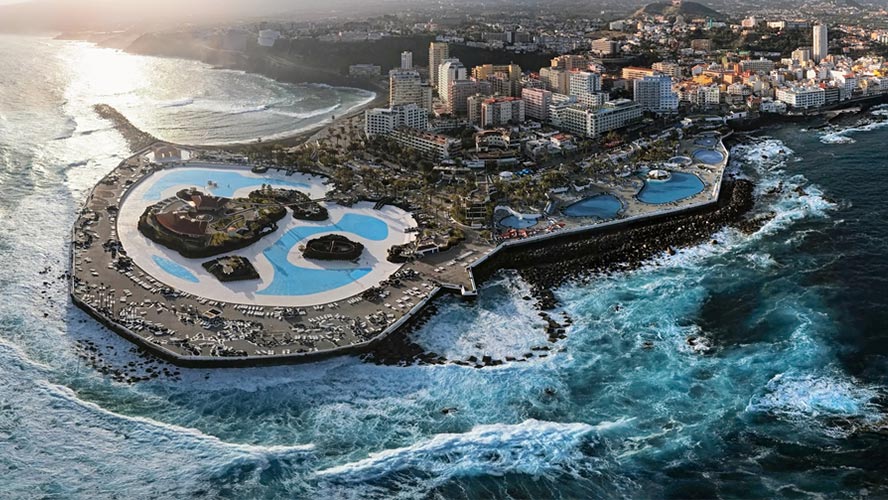
Playa Benijo
This is one of Tenerife’s most fabulous unspoilt beaches. Lying between Roque Benijo and Roque La Rapadura, this beautiful, wild enclave is the perfect place to daydream and feel the power of the Atlantic Ocean. Playa Benijo has black sand, and an average number of visitors during summer, with lower numbers in winter. To enjoy the beach in all its glory, it is worth waiting till low tide. Access is via a path that starts near the road; the walk takes around 15 minutes.
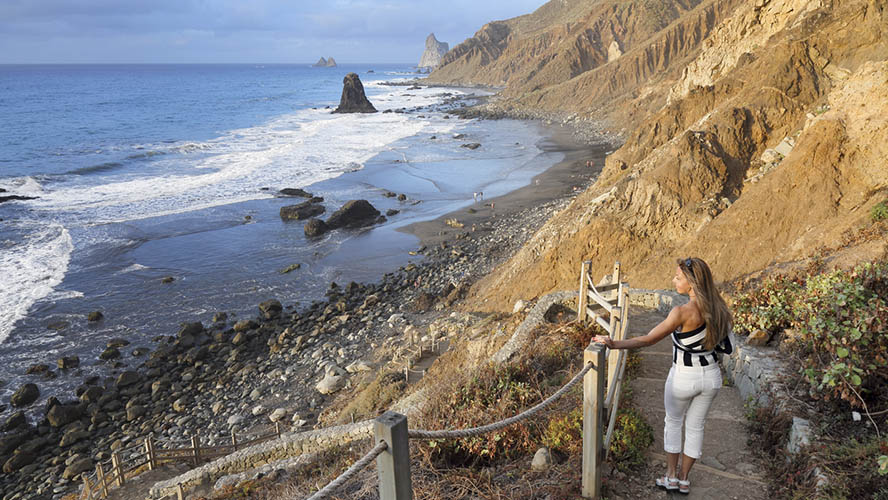
Playa del Duque
This beach, which lies on South Tenerife’s tourist-orientated Costa Adeje, is a perfect place to enjoy the sun, the beach, and all kinds of services and conveniences. It is a long beach, with golden sands and clear waters. It holds the ‘blue badge’ award, and lies close to a delightful seafront promenade packed with snack bars, restaurants and fashion shops. Its point of historic interest is the Castillo del Duque, which dominates one end of the beach. This is what gave this stretch of coastline its name. This is a very safe beach for bathing, as it is protected by a breakwater that weakens the Atlantic swell.
Playa Las Galletas
At over 400 metres in length and with dark brown sand, this urban beach forms part of the little fishing town from which it takes its name: Las Galletas. It is only 15 kilometres from Playa de los Cristianos, but here you can immerse yourself in the local atmosphere and watch the fishermen at work near the jetty. You can even buy some of their fresh catch at the Fish Market. The beach is easy to access by car and offers all kinds of services and facilities: toilets, showers, litter bins, telephones, restaurants, lounger and sunshade hire, yacht club, lifeguards, etc.
Dónde dormir en Tenerife
If you want to enjoy a stay with every comfort and convenience, the best options for hotels in Tenerife are the Barceló Tenerife, the Royal Hideaway Corales Beach-Adults Only, the Allegro Isora, the Occidental Santa Cruz Contemporáneo, the Royal Hideaway Corales Suites and the Barceló Santiago.
The Barceló Tenerife has 331 exclusive guest rooms, and guarantees a relaxing stay in the island’s capital, Santa Cruz de Tenerife. Facilities at the hotel include 8 fabulous outdoor swimming pools, two of which are temperature regulated, in addition to a sailing lake. All this in a fantastic location right by the sea.
The Royal Hideaway Corales Beach-Adults Only is on Costa Adeje, in the south-west of the island, near a town that has kept alive its traditional ways: La Caleta. This is considered one of Spain’s 25 finest hotels, and was designed in the shape of a boat by the architect Leonardo Omar. Every one of its luxury rooms faces the sea. Next to it, the Royal Hideaway Corales Suites offers 114 designer apartments close to La Enramada beach. Here, guests can enjoy a designer holiday with every possible comfort as a family, with friends or as a couple.
The Allegro Isora has 312 apartments on a site covering over 21,000 m2, close to the La Arena beach. The hotel has a superb buffet restaurant, un lounge-bar and a pool bar, in addition to ideal facilities for children, along with an entertainment programme. There is also a modern U-Wellness and fitness centre.
The Occidental Santa Cruz Contemporáneo is situated in the most exclusive part of the Rambla de Santa Cruz, very close to the city’s historic quarter. The hotel has a fantastic swimming pool with a solarium, perfect for enjoying the Canary Island sun, and a wide range of cuisine on offer in its Alfredo Restaurant.
The Barceló Santiago, located in the south of Tenerife, affords stunning views of La Gomera and of the Los Gigantes cliffs, and its guest rooms overlook the sea, the swimming pools or Mount Teide. Lovers of good food will enjoy an exceptional gastronomic experience, ranging from traditional cuisine to international and exotic dishes. The perfect accommodation if you’re looking to disconnect from your daily routine.

























































